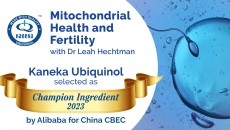Letter to the editor
Comment is free, but fact is sacred: The 3 macular carotenoids are required to enrich macular pigment and optimise vision

A recent study by Irish and UK-based researchers reported recently that a combination of zeaxanthin, lutein, and meso-zeaxanthin may be produce better results that a combination of lutein and zeaxanthin. The study's findings were challenged last week by scientists at Kemin, who stated that there exists "an extensive body of established scientific literature" that consistently reports the efficacy of lutein and zeaxanthin supplementation in the absence of meso-zeaxanthin.
The scientists behind the initial study have now responded to the comments by Kemin. To help further the debate on this topic, we have published the complete response from Dr. John Nolan and Prof. Stephen Beatty from the Macular Pigment Research Group, Vision Research Centre in Waterford, Ireland:
"We would like to address the comments issued by the Kemin Health employees (Dr. Richard Roberts, Principal Manager, Scientific Affairs and Technical Services, Kemin Health; Dr. Justin Green, Technical Service Manager at Kemin Health; and Ms. Samata Maci, Senior Manager Europe, Scientific Affairs and Technical Services, Kemin Health Europe) with respect to the need for all three of macular pigment’s (MP’s) constituent carotenoids to optimise the spatial profile and functionality of MP.
In brief, the statement made by these commentators is as misleading as it is erroneous.
In their opening remarks, these Kemin employees contend that “…the well-established science …do not support …” the growing body of peer-reviewed and published evidence that a formulation containing all three macular carotenoids (meso-zeaxanthin [MZ], lutein [L], and zeaxanthin [Z]) represents the best means of enhancing visual performance in non-diseased eyes. In fact, and in direct contradiction of the assertion put forward by these Kemin employees, there has only ever been one randomised, placebo-controlled, clinical trial comparing changes in MP and visual performance using different carotenoid formulations.1
The results of that study were clear and unambiguous, where it was shown that a formulation containing all three of MPs constituent carotenoids was required to optimise contrast sensitivity under mesopic and photopic conditions and to ameliorate glare disability, whereas no such benefits were seen if the formulation was lacking the centrally dominant carotenoid, MZ.
Indeed, we have been involved in many studies investigating MP response to supplementation with a formulation which contains only two of the three carotenoids that make up MP (L and Z only), which did (as suggested by Roberts, Green and Maci) result in augmentation of MP.2-5
However, the degree of augmentation of MP following supplementation with such formulations which did not contain all three macular carotenoids was disappointing, resulting in equally disappointing results in terms of visual function outcomes.5 Moreover, the poor MP response to formulations which did not contain all three of MPs constituent carotenoids has been commented upon by us and other authors in the past.4, 6 In contrast, the rapid and clinically meaningful rise in MP in response to a formulation that does contain all three of MP’s constituent carotenoids was striking in the early studies,7, 8 a finding that has been consistently replicated.1, 9, 10
Next, Roberts, Green and Maci state that no conclusions can be drawn from MZ supplementation studies because “…up to now, lutein (L) and zeaxanthin (Z) were always present in the MZ formulations evaluated.” This contention by Roberts, Green and Maci is telling indeed, because the “…well established science…” upon which their argument rests is generated exclusively from studies that do not contain MZ. In other words, these Kemin employees have constructed an argument based solely on selective citation of MZ-excluding studies, thereby negating any possibility of scientific progress.
Then, Roberts, Green and Maci point out that “…MP measurement does not discriminate among the three macular carotenoids” and, therefore, that “… an increase in MP after supplementation with MZ, L and Z does not necessarily mean that it is the MZ that has contributed to that increase.” First, we are pleased to see that Roberts, Green and Maci acknowledge that the formulation containing MZ, L and Z results in increased MP, but are confused as to why they feel that MZ did not contribute to the observed increase in MP and consequential improvement in visual function, given that a formulation containing L and Z (but no MZ) failed to do so.1, 9
Next, Roberts, Green and Maci state that “…a proper intake of L and Z without MZ already supplies the eye with the three carotenoids and can increase MP.” and they base their contention in this regard on their assertion in the previous sentence that “(MZ)… is not present in the human diet.” In fact, there have only been two studies designed to investigate the presence or absence of MZ in foodstuffs, both of which found this centrally dominant macular carotenoid to be present in edible foods.11, 12 Furthermore, it is probable that, within the macula, bioconversion of L does generate MZ, and this view is based on the findings of two animal studies (one in monkeys and one in quail).13, 14
However, neither of those animal supplementation studies had an intervention arm for supplemental MZ, and therefore it cannot be concluded that retinal MZ is generated wholly and solely from retinal L. Indeed, the view that ingested L generates sufficient quantities of the required and centrally dominant MZ to generate the typical and desirably peaked spatial profile of MP is inconsistent with the observation that a sizable proportion of the general population lacks a central peak in the MP spatial profile,15, 16 and it is noteworthy that the lack of such a peak is associated with increased risk for age-related macular degeneration.15
Furthermore, the normal and desirable peaked profile of MP (in subjects with atypical spatial profiles of MP) can only be realised following supplementation with a formulation that contains MZ, thus strongly suggesting that a sizeable proportion of the population cannot convert retinal L to MZ.9 Finally, this latter view is supported by the observation that all supplementation studies, where MZ was not included in the formulation, report a sizeable proportion of “non-responders” (subjects in whom MP does not increase in response to supplemental L and Z).2-6
Next, Roberts, Green and Maci hypothesise that “…high MZ is not very well absorbed by the body and that a high MZ can instead have the adverse effect of impairing L and Z absorption.” However, and again, the target tissue is the macula, and there has only ever been one randomised, placebo-controlled, clinical trial comparing changes in MP and visual performance using different carotenoid formulations.1 The results of this study were clear and unambiguous, where it was shown that a formulation containing all three of MPs constituent carotenoids was required to augment MP across it spatial profile (with consequential benefits in terms of visual performance), and this was not the case when the formulation contained only L and Z.1
Then, Roberts, Green and Maci purport to express concern with respect to possible implications for the findings of Meagher et al’s recent paper that could rest on the processes used to prepare and manufacture the formulations employed in that study.17 However, Certificates of Analysis confirm that the MZ formulations used were identical in terms of softgel capsule and in terms of suspension excipients, as these formulations were prepared and manufactured in the same facilities.
In addition, the formulations used were subjected to scrutiny of their content, a process that, in fact, identified a small quantity of MZ in Ultra Lutein (a DSM-sourced lutein product, which claims to contain no MZ).17 Furthermore, and again, the target tissue is the macula, and as previously stated, the presence of all three of MP’s constituent carotenoids results in greater augmentation of MP (and consequential improvement in visual performance) than a formulation lacking MZ, thus allaying any concerns that these Kemin employees may have in this regard.
Finally, and confusingly, Roberts, Green and Maci then attempt to draw an analogy between a supplement such as beta-carotene (or lycopene) and a constituent of MP when attempting to augment MP. Clearly, these Kemin employees need to revisit some basic principles of biochemistry and macular micro-anatomy.
In conclusion, we welcome unstifled debate on the respective roles of MP’s three constituent carotenoids at the macula. However, such debate must be informed by well-designed studies, including randomised, controlled, clinical trials. It is important to contest assumptions which are founded on less-than-perfect studies, including the unproven notion that retinal MZ is derived wholly and solely from retinal L. In summary, therefore, and to use an expression that is appropriate to vision science, “honest debate is better than blind faith.”
Disclosure: Dr. John Nolan (Fulbright Scholar, Howard and European Research Council [ERC] Fellow) is the Principal Investigator of the Macular Pigment Research Group (MPRG, www.mprg.ie). To date, he has secured over 5 million euro in research funding to study the role of carotenoids for eye health. He has published 55 peer-reviewed scientific papers on this research topic (1,001 citations, H index 17). Dr. Nolan is Chair of the International Macular Carotenoids and AMD Conference (www.macularcarotenoids.org). Professor Stephen Beatty (MD) is Director of the MPRG and Institute of Eye Surgery, Waterford, Ireland (www.ivr.ie) (2,332 citations, H index 22). Dr. John M. Nolan and Professor Stephen Beatty do consultancy work for nutraceutical companies, in a personal capacity, and as directors of Nutrasight Consultancy Limited, and these companies include: Kemin Health; DSM; Macuhealth; Macuvision Europe Limited; Novartis Limited; Bayer Healthcare; Abbot; Bausch + Lomb.
References
1. Loughman J, Nolan JM, Howard AN, Connolly E, Meagher K, Beatty S. The impact of macular pigment augmentation on visual performance using different carotenoid formulations. Invest Ophthalmol Vis Sci. 2012:iovs-10690v1.
2. Beatty S, Chakravarthy U, Nolan JM, et al. Secondary Outcomes in a Clinical Trial of Carotenoids with Coantioxidants versus Placebo in Early Age-Related Macular Degeneration. Ophthalmology. 2012:10.
3. Trieschmann M, Beatty S, Nolan JM, et al. Changes in macular pigment optical density and serum concentrations of its constituent carotenoids following supplemental lutein and zeaxanthin: the LUNA study. Exp Eye Res. 2007;84:718-728.
4. Hammond CJ, Liew SM, van Kuijk FJ, et al. The Heritability of Macular Response to Supplemental Lutein and Zeaxanthin: a Classical Twin Study. Invest Ophthalmol Vis Sci. 2012.
5. Nolan JM, Loughman J, Akkali MC, et al. The impact of macular pigment augmentation on visual performance in normal subjects: COMPASS. Vision Res. 2011.
6. Schalch W, Cohn W, Barker FM, et al. Xanthophyll accumulation in the human retina during supplementation with lutein or zeaxanthin - the LUXEA (LUtein Xanthophyll Eye Accumulation) study. Arch Biochem Biophys. 2007;458:128-135.
7. Bone RA, Landrum JT, Cao Y, Howard AN, varez-Calderon F. Macular pigment response to a supplement containing meso-zeaxanthin, lutein and zeaxanthin. Nutr Metab (Lond). 2007;4:12.:12.
8. Connolly EE, Beatty S, Thurnham DI, et al. Augmentation of macular pigment following supplementation with all three macular carotenoids: an exploratory study. Curr Eye Res. 2010;35:335-351.
9. Nolan JM, Akkali MC, Loughman J, Howard AN, Beatty S. Macular carotenoid supplementation in subjects with atypical spatial profiles of macular pigment. Exp Eye Res. 2012.
10. Connolly EE, Beatty S, Loughman J, Howard AN, Louw MS, Nolan JM. Supplementation with all three macular carotenoids: response, stability, and safety. Invest Ophthalmol Vis Sci. 2011;52:9207-9217.
11. Rasmussen H, Muzhingi T, Eggert T, Johnson EJ. Lutein, zeaxanthin, meso-zeaxanthin content in egg yolk and their absence in fish and seafood. Journal of Food Composition and Analysis. 2012;27:139-144.
12. Maoka T, Arai A, Shimizu M, Matsuno T. The first isolation of enantiomeric and meso-zeaxanthin in nature. Comp Biochem Physiol B. 1986;83:121-124.
13. Bhosale P, Serban B, Zhao dY, Bernstein PS. Identification and metabolic transformations of carotenoids in ocular tissues of the Japanese quail Coturnix japonica. Biochemistry. 2007;46:9050-9057.
14. Johnson EJ, Neuringer M, Russell RM, Schalch W, Snodderly DM. Nutritional manipulation of primate retinas, III: effects of lutein or zeaxanthin supplementation on adipose tissue and retina of xanthophyll-free monkeys. Investigative Ophthalmology Visual Science. 2005;46:692-702.
15. Kirby ML, Galea M, Loane E, Stack J, Beatty S, Nolan JM. Foveal anatomic associations with the secondary peak and the slope of the macular pigment spatial profile. Invest Ophthalmol Vis Sci. 2009;50:1383-1391.
16. Kirby ML, Beatty S, Loane E, et al. A Central Dip in the Macular Pigment Spatial Profile is Associated with Age and Smoking. Invest Ophthalmol Vis Sci. 2010.
17. Meagher KA, Thurnham DI, Beatty S, et al. Serum response to supplemental macular carotenoids in subjects with and without age-related macular degeneration. Br J Nutr. 2012:1-12.

















